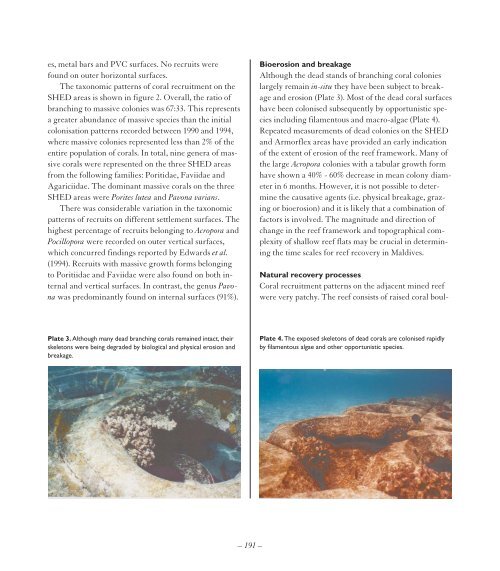You also want an ePaper? Increase the reach of your titles
YUMPU automatically turns print PDFs into web optimized ePapers that Google loves.
es, metal bars and PVC surfaces. No recruits were<br />
found on outer horizontal surfaces.<br />
The taxonomic patterns of coral recruitment on the<br />
SHED areas is shown in figure 2. Overall, the ratio of<br />
branching to massive colonies was 67:33. This represents<br />
a greater abundance of massive species than the initial<br />
colonisation patterns recorded between 1990 and 1994,<br />
where massive colonies represented less than 2% of the<br />
entire population of corals. In total, nine genera of massive<br />
corals were represented on the three SHED areas<br />
from the following families: Poritidae, Faviidae and<br />
Agariciidae. The dominant massive corals on the three<br />
SHED areas were Porites lutea and Pavona varians.<br />
There was considerable variation in the taxonomic<br />
patterns of recruits on different settlement surfaces. The<br />
highest percentage of recruits belonging to Acropora and<br />
Pocillopora were recorded on outer vertical surfaces,<br />
which concurred findings reported by Edwards et al.<br />
(1994). Recruits with massive growth forms belonging<br />
to Poritiidae and Faviidae were also found on both internal<br />
and vertical surfaces. In contrast, the genus Pavona<br />
was predominantly found on internal surfaces (91%).<br />
Bioerosion and breakage<br />
Although the dead stands of branching coral colonies<br />
largely remain in-situ they have been subject to breakage<br />
and erosion (Plate 3). Most of the dead coral surfaces<br />
have been colonised subsequently by opportunistic species<br />
including filamentous and macro-algae (Plate 4).<br />
Repeated measurements of dead colonies on the SHED<br />
and Armorflex areas have provided an early indication<br />
of the extent of erosion of the reef framework. Many of<br />
the large Acropora colonies with a tabular growth form<br />
have shown a 40% - 60% decrease in mean colony diameter<br />
in 6 months. However, it is not possible to determine<br />
the causative agents (i.e. physical breakage, grazing<br />
or bioerosion) and it is likely that a combination of<br />
factors is involved. The magnitude and direction of<br />
change in the reef framework and topographical complexity<br />
of shallow reef flats may be crucial in determining<br />
the time scales for reef recovery in Maldives.<br />
Natural recovery processes<br />
Coral recruitment patterns on the adjacent mined reef<br />
were very patchy. The reef consists of raised coral boul-<br />
Plate 3. Although many dead branching corals remained intact, their<br />
skeletons were being degraded by biological and physical erosion and<br />
breakage.<br />
Plate 4. The exposed skeletons of dead corals are colonised rapidly<br />
by filamentous algae and other opportunistic species.<br />
– 191 –


















